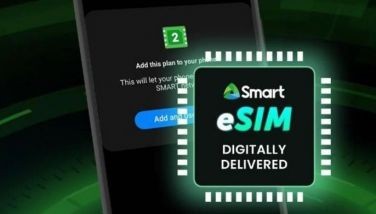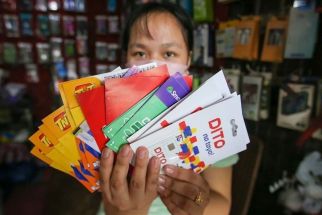Smartphone sensations
June 3, 2002 | 12:00am
When PDA maker Handspring announced a few months back that its Treo Communicator would integrate a fully functioning colored Palm device into a dual-band GSM cellular phone, many saw the new device as a breakthrough product.
A device that can function as a cellular phone, a personal digital assistant and a handheld computer is something of a dream machine. Such a device will give users maximum wireless connectivity to the Internet and easy access to personal information even as it works for voice calls and sending and receiving SMS messages. Such a device will also be more portable and can eliminate carrying around two to three different gadgets at the same time.
No sooner did Handspring make its Treo announcement that a number of "smartphone" manufacturers leaked out information about their own models. Unlike the Handspring Treo, which runs the latest version of Palm’s operating system, most of the other smartphone manufacturers went with Microsoft’s Smartphone 2002 operating system that is a derivative of Microsoft’s increasingly popular PocketPC 2002 operating system for handheld devices.
Companies like Kyocera, Samsung, O2, Sendo, Siemens-Fujitsu and even Microsoft are betting heavily that these phone-PDA hybrids will be the next hottest telecommunications items. By running a Microsoft OS, these devices will synch easily with desktops and will be able to function as calendars and schedule keepers while on the road. They will most likely have the ability to run scaled-down versions of Office applications such as Microsoft Word and Microsoft Excel.
Many of the new smartphone models share similar specifications. Expect the first batch of smartphones to max out at 15 hours for PDA use per charge. As phones, they should handle about 3.5 hours for talk time, partly possible because of new lithium polymer battery technology. Many of these devices are certain to have at least an Intel StrongARM 32-bit processor with 32Mb of onboard RAM and one can expect to get added storage from Secure Digital and MultiMedia add-on cards.
High-resolution, color screens make these smartphones easier on the eyes as well as great for sending and receiving e-mail or surfing the Internet through the mini-browser bundled in the operating system.
GPRS capability means that these smartphones will be able to access the Internet at near broadband speeds, making them perfect tools for executives and salespeople who need access to e-mail while on the road. These smartphones will also be able to expand the possibilities of mobile commerce and mobile transactions way beyond the current phones’ capabilities that are based purely on SMS transactions and are essentially text-based and often cumbersome to use.
A bona fide operating system running on the phone rather than firmware will enable encryption and software security to be easily accessed when users are viewing websites or making transactions via their phones. These new smartphones look like a good alternative to DoCoMo’s 3G handsets.
The big question is whether consumers will be quick to accept the devices. One determining factor is the price; PocketPC PDAs and most high-end cellular phones are far from cheap. A hybrid product that incorporates the functions of both and give additional advantages is certain to carry a larger price tag. Handspring’s Treo, expected to be a more affordable model, may be priced at $500. Consumers then can expect to pay anywhere from $600 to $900 for similar smartphones. At this price, consumers can buy a full featured and branded desktop system with all the bells and whistles so it might be difficult to convince them to purchase a smartphone for the same amount.
Certainly, a lot of early adopters will line the malls to be one of the first to own these pocket wonders, but they may be limited to the executive market of CEOs and VPs who can afford to splurge. Until smartphones gain critical mass and their prices are lowered considerably, it is doubtful that the millions of cellphone and PDA owners will discard their reliable models for more expensive and untested hybrids.
It is still very early in the race, however, and if these smartphones can successfully be built in great numbers the same way cellular handsets are currently made and sold, then they might be positioned to take over that entire segment. This will certainly take some time. The best thing about the new breed of smartphones is that they manage to push the boundaries of technology and telecommunications even further and are introducing promising features that are sure to dictate the future of the cellular handset.
A device that can function as a cellular phone, a personal digital assistant and a handheld computer is something of a dream machine. Such a device will give users maximum wireless connectivity to the Internet and easy access to personal information even as it works for voice calls and sending and receiving SMS messages. Such a device will also be more portable and can eliminate carrying around two to three different gadgets at the same time.
No sooner did Handspring make its Treo announcement that a number of "smartphone" manufacturers leaked out information about their own models. Unlike the Handspring Treo, which runs the latest version of Palm’s operating system, most of the other smartphone manufacturers went with Microsoft’s Smartphone 2002 operating system that is a derivative of Microsoft’s increasingly popular PocketPC 2002 operating system for handheld devices.
Companies like Kyocera, Samsung, O2, Sendo, Siemens-Fujitsu and even Microsoft are betting heavily that these phone-PDA hybrids will be the next hottest telecommunications items. By running a Microsoft OS, these devices will synch easily with desktops and will be able to function as calendars and schedule keepers while on the road. They will most likely have the ability to run scaled-down versions of Office applications such as Microsoft Word and Microsoft Excel.
Many of the new smartphone models share similar specifications. Expect the first batch of smartphones to max out at 15 hours for PDA use per charge. As phones, they should handle about 3.5 hours for talk time, partly possible because of new lithium polymer battery technology. Many of these devices are certain to have at least an Intel StrongARM 32-bit processor with 32Mb of onboard RAM and one can expect to get added storage from Secure Digital and MultiMedia add-on cards.
High-resolution, color screens make these smartphones easier on the eyes as well as great for sending and receiving e-mail or surfing the Internet through the mini-browser bundled in the operating system.
GPRS capability means that these smartphones will be able to access the Internet at near broadband speeds, making them perfect tools for executives and salespeople who need access to e-mail while on the road. These smartphones will also be able to expand the possibilities of mobile commerce and mobile transactions way beyond the current phones’ capabilities that are based purely on SMS transactions and are essentially text-based and often cumbersome to use.
A bona fide operating system running on the phone rather than firmware will enable encryption and software security to be easily accessed when users are viewing websites or making transactions via their phones. These new smartphones look like a good alternative to DoCoMo’s 3G handsets.
The big question is whether consumers will be quick to accept the devices. One determining factor is the price; PocketPC PDAs and most high-end cellular phones are far from cheap. A hybrid product that incorporates the functions of both and give additional advantages is certain to carry a larger price tag. Handspring’s Treo, expected to be a more affordable model, may be priced at $500. Consumers then can expect to pay anywhere from $600 to $900 for similar smartphones. At this price, consumers can buy a full featured and branded desktop system with all the bells and whistles so it might be difficult to convince them to purchase a smartphone for the same amount.
Certainly, a lot of early adopters will line the malls to be one of the first to own these pocket wonders, but they may be limited to the executive market of CEOs and VPs who can afford to splurge. Until smartphones gain critical mass and their prices are lowered considerably, it is doubtful that the millions of cellphone and PDA owners will discard their reliable models for more expensive and untested hybrids.
It is still very early in the race, however, and if these smartphones can successfully be built in great numbers the same way cellular handsets are currently made and sold, then they might be positioned to take over that entire segment. This will certainly take some time. The best thing about the new breed of smartphones is that they manage to push the boundaries of technology and telecommunications even further and are introducing promising features that are sure to dictate the future of the cellular handset.
BrandSpace Articles
<
>
- Latest
Latest
Latest
December 11, 2023 - 11:00am
December 11, 2023 - 11:00am
November 23, 2023 - 4:35pm
November 23, 2023 - 4:35pm
October 16, 2023 - 5:00pm
October 16, 2023 - 5:00pm
August 24, 2023 - 4:43pm
August 24, 2023 - 4:43pm
August 17, 2023 - 9:50am
August 17, 2023 - 9:50am
Recommended



























